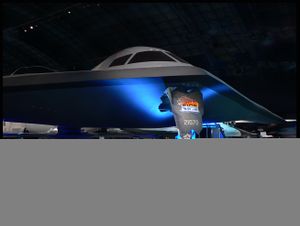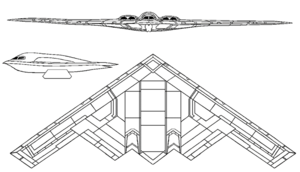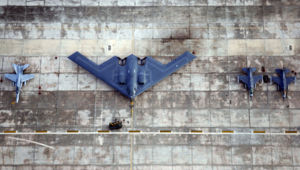PlaneSpottingWorld welcomes all new members! Please gives your ideas at the Terminal.
B-2 Spirit
| B-2 Spirit | |
|---|---|
| A USAF B-2 Spirit in flight. | |
| Type | Stealth bomber |
| Manufacturer | Northrop Corporation Northrop Grumman |
| Maiden flight | 1989-07-17 |
| Introduced | April 1997 |
| Status | Active service |
| Primary user | United States Air Force |
| Number built | 21 |
| Unit cost | US$1.157-$2.2 billion in 1998 |
The Northrop Grumman B-2 Spirit is a multi-role stealth bomber able to drop conventional and nuclear weapons. The bomber was a milestone in the bomber modernization program of the United States.
The B-2 is one of the most expensive planes ever built: estimates for the costs per plane range from 1.157 billion [1] to 2.2 billion US dollars.[2] By comparison, a Nimitz class aircraft carrier costs $4.5 billion. However, quoted cost figures are highly inflated by the inclusion of the aircraft's enormous development cost and infrastructure development costs in the unit price; published estimates have shown the unit "production" cost for the aircraft alone is approximately $150 million per aircraft.
Its stealth technology is intended to help the craft penetrate defenses previously impenetrable by combat aircraft. The original procurement of 135 aircraft was later reduced to 75 in the late 1980s. In his 1992 State of the Union address, President George H. W. Bush announced total B-2 production would be limited to 20 aircraft (later increased to 21 by refurbishing a test aircraft).
Contents
Features
With the B-52 Stratofortress and B-1 Lancer, the U.S. military claims that the B-2 provides the versatility inherent in manned bombers. Its low-observable, or "stealth," characteristics give it the ability to penetrate an enemy's most sophisticated defenses and attack its most heavily defended targets.
The blending of low-observable technologies with high aerodynamic efficiency and large payload gives the B-2 significant advantages over previous bombers. Its traveling range is approximately 6,000 nautical miles (11,100 km) without refueling. Also, its low-observation ability provides the B-2 greater freedom of action at high altitudes, thus increasing its range and a better field of view for the aircraft's sensors. With its GPS Aided Targeting System (GATS) combined with GPS-aided bombs such as Joint Direct Attack Munition (JDAM), it can use its passive electronically scanned array APQ-181 radar to correct GPS errors of targets and gain much better than laser-guided weapon accuracy with "dumb" gravity bombs with a GPS-aided "smart" guidance tail kit attached. It can bomb 16 targets in a single pass when equipped with 1000 or 2000-pound bombs, or as many as 80 when carrying 500-pound bombs.
The B-2's stealth comes from a combination of reduced acoustic, infrared, visual and radar signatures, making it difficult for defences to detect, track and engage. Many aspects of the low-observability process remain classified; however, the B-2's composite materials, special coatings and flying wing design contribute to its stealth abilities.
The B-2 has a crew of two; a pilot in the left seat and mission commander in the right, compared to the B-1B's crew of four and the B-52's crew of five.
Operational history
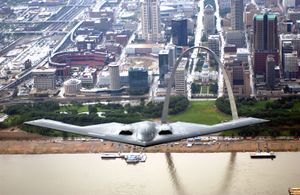
The B-2 started life as a black project known as the High Altitude Penetrating Bomber (HAPB), then became the Advanced Technology Bomber (ATB) and used the project code word Senior Cejay. It later became the B-2 Spirit. An estimated 23 billion US dollars were secretly spent for research and development on the B-2 in the 1980s. An additional expense was caused by changing its role in 1985 from a high-altitude bomber to a low-altitude bomber, which required a major redesign. The first B-2 was publicly displayed on November 22 1988, when it was rolled out of its hangar at Air Force Plant 42, Palmdale, California, where it was built. Its first flight was on July 17 1989. The B-2 Combined Test Force, Air Force Flight Test Center, Edwards Air Force Base, California, is responsible for flight testing the engineering, manufacturing and development aircraft.
The first aircraft, named Spirit of Missouri, was delivered on December 17 1993. Depot maintenance responsibility for the B-2 is held by United States Air Force contractor support and is managed at the Oklahoma City Air Logistics Center at Tinker Air Force Base in Oklahoma.
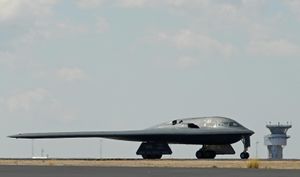
The prime contractor, responsible for overall system design and integration, is Northrop Grumman Integrated Systems Sector. Boeing Integrated Defense Systems, Hughes Aircraft (now Raytheon), General Electric Aircraft Engines and Vought Aircraft Industries, are members of the aircraft contractor team. Another contractor, responsible for aircrew training devices (weapon system trainer and mission trainer) is Link Simulation & Training, a division of L-3 Communications formerly Hughes Training Inc. (HTI).[3] Link Division, formerly known as CAE - Link Flight Simulation Corp. Link Simulation & Training is responsible for developing and integrating all aircrew and maintenance training programs. The military contractors for the B-2 engaged in massive lobbying campaigns to gain Congressional support for its funding.[citation needed]
Whiteman Air Force Base in Missouri was the B-2's only operational base until early 2003, when facilities for the B-2 were built on the joint U.S./U.K. military base on the British island of Diego Garcia in the Indian Ocean, followed by deployment to Guam in 2005. Facilities for the aircraft have also been built at RAF Fairford in Gloucestershire in the United Kingdom.
Questions remain over the rising cost of the program: some writers have suggested that the huge cost may include costs for other black projects. The expense may also be partially explained by the small number of planes produced coupled with a large research overhead in the B-2 program.[4]
These bombers were originally designed to drop nuclear weapons during the Cold War and support for them dwindled as military spending declined. In May of 1995, in a study commissioned by Congress, the Institute For Defense Analysis concluded that after the demise of the Soviet Union, there was no need for more B-2s.
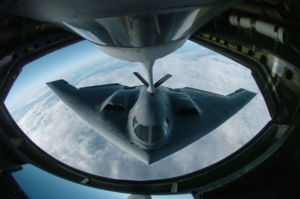
Combat
The B-2 was derided by many as being too expensive to risk in combat. However, the aircraft has seen service in three separate campaigns.
Its debut was during the Kosovo War in 1999. The B-2 first introduced the satellite guided JDAM in combat use. Since then, the aircraft has operated over Afghanistan in Operation Enduring Freedom and Iraq in Operation Iraqi Freedom.
The raids on Afghanistan saw a first for the aircraft. After flying bombing missions over Afghanistan, the aircraft landed at Diego Garcia, were refueled and had a crew change before another sortie. This was taken a step further during the Iraq campaign when B-2s were based at Diego Garcia.
Later missions to Iraq came from Whiteman AFB in Missouri. This resulted in missions lasting over 30 hours and one mission of over 50 hours. The B-2 is highly automated, and unlike single-seat fighters, one crewmember can sleep, use a flush toilet or prepare a hot meal while the other monitors the aircraft.
The Pentagon's Operational Test and Evaluation 2003 Annual Report noted that the B-2's serviceability for FY03 was still inadequate, mainly due to maintenance on the B-2's Low Observable materials, the Evaluation also noted that the Defensive Avionics suite also had shortcomings in warning of pop-up threats[5]. Despite these problems the B-2 was declared to be in full operational capability in December of 2003[6]. The B-2 maintained high serviceability for Operation Iraqi Freedom, dropping 583 JDAMs during the war.[7]
B-2 on display
Because of their cost, rarity and combat value it is unlikely any B-2 will be placed on permanent display in the near future (or anytime before airframe retirement). However, they are periodically on temporary ground display at various airshows, including one at Tinker Air Force Base, Midwest City, Oklahoma in June of 2005. In 2004 the static test mock-up for the B-2 was placed on display at the National Museum of the United States Air Force near Dayton, Ohio. The mock-up had been used for structural testing, and at one point was tested to the point of destruction. The Museum's restoration team spent over a year reassembling the fractured airframe, and patches can clearly be seen on the exterior of the airframe where fractured sections have been reattached.
From 1989 to 2004, the South Dakota Air and Space Museum located on the grounds of Ellsworth Air Force Base displayed a 10-ton, 3/5 scale "Honda Stealth," a mock-up of a stealth bomber built by North American Honda in 1988 for a national automobile campaign. The mockup is not an actual replica of a B-2, but was close enough to create a stir that Honda had cracked national security, as the B-2 project was still officially classified in 1988.[8] Honda donated the model to the Museum in 1989, with the stipulation the model be destroyed if it was replaced with a different aircraft. The Honda Stealth was dismantled and replaced with a B-1 Lancer aircraft in 2005.[9][10]
A B-2 Spirit participated in the Air Force Memorial dedication ceremony on October 14, 2006.
Recent Events regarding B-2
Noshir Gowadia, the design engineer in charge of the propulsion system was arrested on October 2005 for selling classified information to China, and possibly other countries as well. Trial is scheduled for 10 July 2007.[11]
Units using the B-2
United States Air Force
- 509th Bomb Wing, Whiteman Air Force Base
- 53d Wing, Eglin Air Force Base
- 57th Wing, Nellis Air Force Base
Specifications (B-2A Block 30)
General characteristics
- Crew: 2
- Length: 69 ft (20.9 m)
- Wingspan: 172 ft (52.12 m)
- Height: 17 ft (5.1 m)
- Wing area: 5,000 ft² (460 m²)
- Empty weight: 158,000 lb (71,700 kg)
- Loaded weight: 336,500 lb (152,600 kg)
- Max takeoff weight: 376,000 lb (171,000 kg)
- Powerplant: 4× General Electric F118-GE-100 turbofans, 17,300 lbf (77 kN) each
Performance
- Maximum speed: 410 knots (475 mph, 764 km/h)
- Range: 6,500 mi (5,600 nm, 10,400 km)
- Service ceiling: 50,000 ft (15,000 m)
- Wing loading: 67.3 lb/ft² (329 kg/m²)
- Thrust/weight: 0.205
Armament
- 40,000 lb (18,000 kg) of Bomb Rack Assembly mounted 500 lb class bombs (Mk82) (total carriage quantity: 80)
- 27,000 lb (12,000 kg) of BRA mounted 750 lb CBU class bombs (total carriage quantity: 36)
- 16 Rotary Launcher Assembly (RLA) mounted 2000 lb class weapons (Mk84, JDAM-84, JDAM-102)
- 16 RLA mounted B61 or B83 nuclear weapons
Later avionics and equipment improvements allow B-2A to carry JSOW and GBU-28s as well. The Spirit is also designated as a delivery aircraft for the AGM-158 JASSM when the missile enters service.
List of B-2 bombers
| Designation | Tail # | Formal name | |
|---|---|---|---|
| AV-1 | 82-1066 | Spirit of America | |
| AV-2 | 82-1067 | Spirit of Arizona | |
| AV-3 | 82-1068 | Spirit of New York | |
| AV-4 | 82-1069 | Spirit of Indiana | |
| AV-5 | 82-1070 | Spirit of Ohio | |
| AV-6 | 82-1071 | Spirit of Mississippi | |
| AV-7 | 88-0328 | Spirit of Texas | |
| AV-8 | 88-0329 | Spirit of Missouri | |
| AV-9 | 88-0330 | Spirit of California | |
| AV-10 | 88-0331 | Spirit of South Carolina | |
| AV-11 | 88-0332 | Spirit of Washington | |
| AV-12 | 89-0127 | Spirit of Kansas | |
| AV-13 | 89-0128 | Spirit of Nebraska | |
| AV-14 | 89-0129 | Spirit of Georgia | |
| AV-15 | 90-0040 | Spirit of Alaska | |
| AV-16 | 90-0041 | Spirit of Hawaii | |
| AV-17 | 92-0700 | Spirit of West Virginia | |
| AV-18 | 93-1085 | Spirit of Oklahoma | |
| AV-19 | 93-1086 | Spirit of Kitty Hawk | |
| AV-20 | 93-1087 | Spirit of Pennsylvania | |
| AV-21 | 93-1088 | Spirit of Louisiana | |
| AV-22–AV-135 cancelled | |||
References
- ↑ http://www.aerospaceweb.org/aircraft/bomber/b2/
- ↑ http://www.cdi.org/issues/aviation/B296.html
- ↑ http://www.link.com/b2atd.html
- ↑ http://www.fas.org/man/gao/gao94217.htm
- ↑ Popup is an informative call of a contact that has suddenly appeared inside of meld/CCR/briefed range.
- ↑ http://www.af.mil/factsheets/factsheet.asp?fsID=82
- ↑ http://pogo.org/m/dp/dp-2003-B2.pdf
- ↑ Black Hills Attractions
- ↑ Museum slices stealth display
- ↑ B-1 to go on display in museum
- ↑ FBI Honolulu Press Release
- CNN - B-2 stealth bombers make combat debut - March 24, 1999
- FAS - B-2 Spirit - United States Nuclear Forces
- Air Force Link - Fact Sheet : B-2 Spirit
See also
- Northrop YB-49
- List of active United States military aircraft
- List of bomber aircraft
- List of flying wing aircraft
- List of military aircraft of the United States
External links
- Home of America´s Bomber - The B-2 Spirit of Whiteman Air Force Base
- B-2 Spirit page on NorthropGrumman.com
- B-2 Spirit USAF fact sheet
- Pentagon Operational Test and Evaluation 2003 Annual Report
- B-2 Spirit page on GlobalSecurity.org
- B-2 Spirit Stealth Bomber page on bugimus.com
- B-2 Spirit (Stealth Bomber) page on Aircraft-Info.net
Fighters: FT · XP-56 · P-61 · F2T · XP-79 · F-89 · F-5 · CF-116 · YF-17 · F-18L · F-20 · YF-23
Attack: YA-13 · XA-16 · A-17 · BT · SBT · YA-9 - Bombers: YB-35 · B2T · YB-49 · B-62 · B-2
Transports: Alpha · C-19 · Beta · C-100 Gamma · RT Delta · YC-125
Reconnaissance: F-15 · RF-5 · TR-3 - Trainers: T-38
Experimental: N-1M · N-9M · MX-324 · X-4 · M2-F2 · M2-F3 · HL-10 · Tacit Blue · X-21
Lists relating to aviation | |
|---|---|
| General | Timeline of aviation · Aircraft · Aircraft manufacturers · Aircraft engines · Aircraft engine manufacturers · Airports · Airlines |
| Military | Air forces · Aircraft weapons · Missiles · Unmanned aerial vehicles (UAVs) · Experimental aircraft |
| Notable incidents and accidents | Military aviation · Airliners · General aviation · Famous aviation-related deaths |
| Records | Flight airspeed record · Flight distance record · Flight altitude record · Flight endurance record · Most produced aircraft |
ar:ب 2 سبيريت cs:B-2 Spirit da:B-2 Spirit de:Northrop B-2 es:B-2 Spirit fr:Northrop B-2 Spirit ko:B-2 스피릿 it:Northrop-Grumman B-2 Spirit he:B-2 ספיריט ms:B-2 Spirit nl:B-2 Spirit ja:B-2 (爆撃機) no:Northrop B-2 Spirit pl:Northrop B-2 Spirit pt:B-2 Spirit ru:B-2 Spirit fi:B-2 Spirit vi:B-2 Spirit tr:B-2 Spirit ur:بی-2 سپرٹ zh:B-2幽灵隐形战略轰炸机

